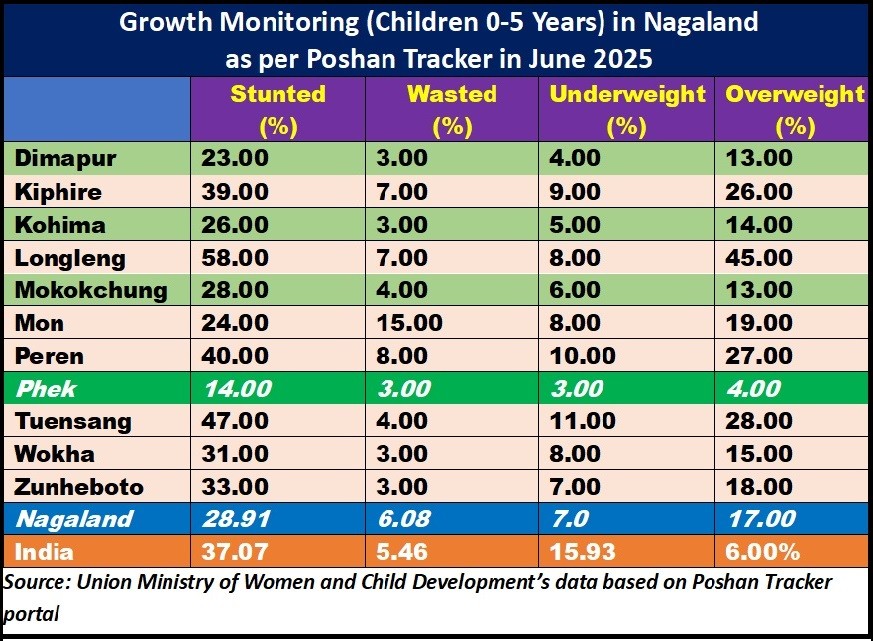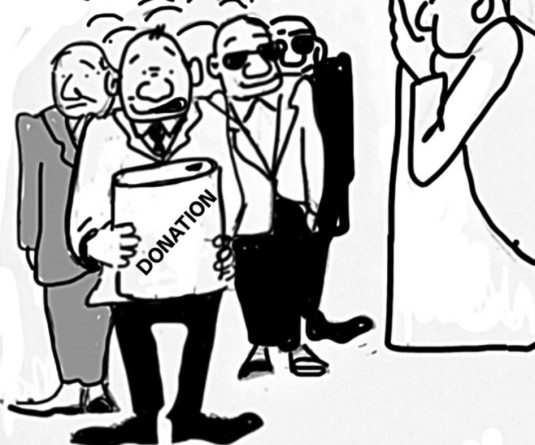
Moa Jamir
Dimapur | July 23
Nagaland continues to face a “double burden” of malnutrition among children under five, with notably high rates of both stunting and overweight, according to government data.
Data provided in a written reply to an Unstarred Question in the Rajya Sabha on July 23 by the Union Ministry of Women and Child Development (WCD), supplemented by statistics from the Ministry’s Poshan Tracker portal, also highlighted significant regional disparities in the nutritional status of children in the State.
At the national level, 37.07% of children were reported to be stunted. As per the WCD, stunting refers to children whose height-for-age is below the World Health Organization (WHO) Child Growth Standards median, indicating chronic malnutrition. In comparison, Nagaland’s stunting rate stood at 28.91%.
Wasting—defined as low weight-for-height due to food scarcity or infection—stood at 5.46% nationally and 6.08% in Nagaland.
Nagaland fared significantly better in terms of underweight prevalence, recording 7.00% compared to the national average of 15.93%. Underweight is a composite measure reflecting both stunting and wasting, determined by low weight-for-age.
However, the state showed a worrying trend in overweight cases. Overweight refers to children whose weight-for-height exceeds the norm, often associated with poor diet diversity and excessive calorie intake. While 6.00% of children in India were categorised as overweight, Nagaland reported a significantly higher figure of 17.00%, as per Poshan Tracker data for June.
In June, a total of 50,703 children were measured in Nagaland under growth monitoring. Nationally, over 7 crore children were covered during the same period.
Growth Monitoring (Children 0-5 Years) in Nagaland as per Poshan Tracker in June 2025 | ||||
| Stunted (%) | Wasted (%) | Underweight (%) | Overweight (%) |
Dimapur | 23.00 | 3.00 | 4.00 | 13.00 |
Kiphire | 39.00 | 7.00 | 9.00 | 26.00 |
Kohima | 26.00 | 3.00 | 5.00 | 14.00 |
Longleng | 58.00 | 7.00 | 8.00 | 45.00 |
Mokokchung | 28.00 | 4.00 | 6.00 | 13.00 |
Mon | 24.00 | 15.00 | 8.00 | 19.00 |
Peren | 40.00 | 8.00 | 10.00 | 27.00 |
Phek | 14.00 | 3.00 | 3.00 | 4.00 |
Tuensang | 47.00 | 4.00 | 11.00 | 28.00 |
Wokha | 31.00 | 3.00 | 8.00 | 15.00 |
Zunheboto | 33.00 | 3.00 | 7.00 | 18.00 |
Nagaland | 28.91 | 6.08 | 7.0 | 17.00 |
India | 37.07 | 5.46 | 15.93 | 6.00% |
Source: Union Ministry of Women and Child Development’s data based on Poshan Tracker portal
Wide district-wise disparities
An analysis of district-level data from the Poshan Tracker revealed substantial disparities across Nagaland.
Longleng recorded the highest stunting rate at 58%, along with the highest overweight prevalence at 45%. Tuensang followed with 47% stunting and 28% overweight, while Kiphire (39% stunting; 26% overweight) and Peren (40%; 27%) also reflected similar dual burdens.
Mon recorded the highest wasting prevalence at 15%, despite a relatively moderate stunting rate of 24%. On the other hand, Phek showed the most favourable outcomes, with stunting at 14% and overweight at 4%. It was the only district where all indicators were better than the national average.
A total of 5493 children aged 0–5 years were measured across districts in June, according to the Poshan Tracker data.
Further, Kohima, Mokokchung, and Dimapur also performed better than the State’s average of 28.91% stunting, 6.08% wasting, 7.00% underweight, and 17.00% overweight.
Nagaland’s current stunting rate marks an improvement from the fifth National Family Health Survey (NFHS-5), conducted during 2019–2021, which reported that 32.7% of children under five in the State were stunted. The June data is similar to 28.6% in NFHS-4 (2015–2016).
While the NFHS-5 showed that 7.9% of children under five were severely wasted (low weight-for-height), indicating acute malnutrition, it seems to have fallen to 6.08%, at least for June.
The current figures on underweight children also reflected significant progress, improving from 26.9% in NFHS-5 to 7.00% as per the latest Poshan Tracker data. However, the prevalence of overweight children has risen from 4.9% in NFHS-5 to weighty 17.00%, indicating a growing trend of obesity.
Only 700 Anganwadi Centres functions regularly
While the growth monitoring figures reflect a significant sample size, data on the functioning of Anganwadi Centres (AWCs) suggest inconsistencies in service delivery.
Out of 3,980 registered AWCs in Nagaland, 2,576 were open for at least 15 days in June.
This number dropped to 1,834 centres functioning for at least 21 days and only 700 centres that remained operational for 25 days or more.





